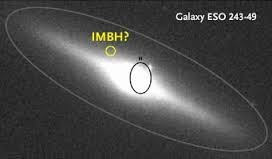 Black holes observed by astronomers have masses either similar to those of stars, or are supermassive, with masses larger than millions of solar masses. Stellar-mass black hole are the end-product of the evolution of massive stars but supermassive black holes had to grow up from less massive black holes swallowing matter through what is called accretion. Also mergers of black holes always end up in a black hole more massive than the merging components. Either way one expects that at least some intermediate mass black should be left over and observed. But none have been found with certainty.
Black holes observed by astronomers have masses either similar to those of stars, or are supermassive, with masses larger than millions of solar masses. Stellar-mass black hole are the end-product of the evolution of massive stars but supermassive black holes had to grow up from less massive black holes swallowing matter through what is called accretion. Also mergers of black holes always end up in a black hole more massive than the merging components. Either way one expects that at least some intermediate mass black should be left over and observed. But none have been found with certainty.
Black hole being really black, they can be observed only through their action on other forms of matter, for example when gas is falling onto a black hole - when it is being accreted - it heats-up to high temperatures and emits large amount of X-rays. Several such very bright X-ray sources, called ULXs - from Ultra Luminous X-ray (sources) have been suspected to contain the elusive intermediate mass black hole (IMBH). ULXs are found in binaries because only a stellar companion can provide the required amount of matter observed to radiate X-rays. This radiation, however, exerts pressure that pushes back the very matter which produces it: above a certain critical value, called the Eddington luminosity matter stopped from accreting onto the black hole. The Eddington luminosity is proportional to the mass of the accreting object, so it was obvious to conclude that ULXs emitting 100 times the Eddington luminosity corresponding to one solar mass have mass larger than 100 solar masses since they accrete and radiate. It seemed that IMBH have been finally identified. But last year it was found that one of the brightest ULXs contains an X-ray pulsar which must be a neutron star, certainly not a black hole (which being featureless cannot pulse). And the mass of a neutron star is just slightly larger than the mass of the Sun. Almost at the same time the mass of another ULX was measured and found to be less than 15 solar masses. So it was not only found that ULX do not have to be IMBX but by the same, it was established that accretion producing 100 Eddington luminosities is possible, since it has been observed!
The IMBH fans, however, still had one last hope: the X-ray source HLX-1 in the galaxy ESO 243-49 discovered in 2009 by observers from the Toulouse Observatory. "HL" stands for hyper-luminous because its luminosity is 10 000 times larger than the Eddington luminosity for one solar mass. So its mass could be 10000 solar masses making it a real intermediate mass black. HLX-1 is variable:most of the time it is barely visible but every few hundred days it goes to outburst and within less that a week it becomes hyper-luminous. Then, during less than six months, its luminosity decays back to quiescence. A similar behaviour is observed in so-called X-ray transients and is well explained by an instability in the accretion disc that forms around the black holes in such systems. The characteristic times (days, months) observed during X-ray transient outbursts correspond to the stellar masses of their black holes, but because these times depend strongly on mass, such short times totally preclude the presence of a 10 000 solar mass black hole in HLX-1 - its outbursts would have to last centuries, not months. On the other hand, X-ray transients have never been observed to have super-Eddington luminosities.
Jean-Pierre Lasota from CAMK and IAP, Andrew King from Leicester University and Guillaume Dubus from Grenoble Observatory proposed a solution of this contradiction between time and luminosity. They showed that HLX-1 can be a member of a new class of systems: the super-Eddington X-ray transients and that the mass of its black hole can be equal to just few solar masses. They suggest that other ULX belong to this new category of X-tay sources. If confirmed this will be the final nail in the coffin of intermediate mass black holes
in X-ray binaries.
Jean-Pierre Lasota, Andrew King & Guillaume Dubus 2015, X-ray Transients: Hyper- or Hypo-Luminous? Astrophysical Journal Letters, 801, L4.






